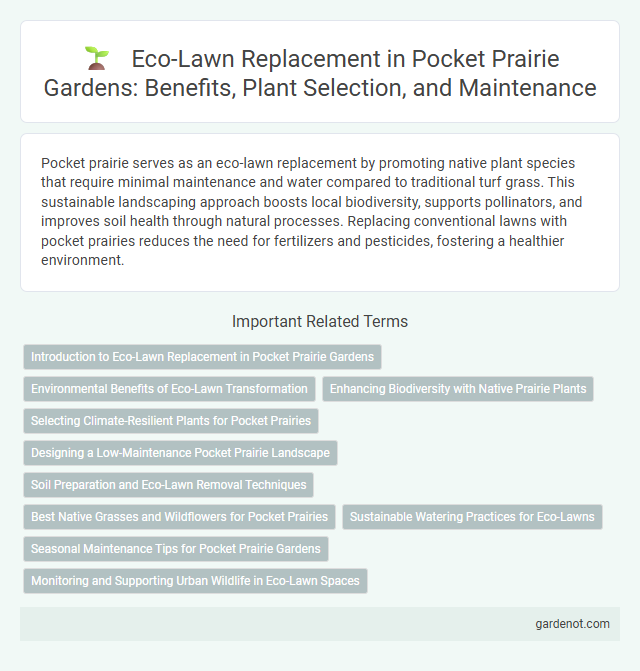Pocket prairie serves as an eco-lawn replacement by promoting native plant species that require minimal maintenance and water compared to traditional turf grass. This sustainable landscaping approach boosts local biodiversity, supports pollinators, and improves soil health through natural processes. Replacing conventional lawns with pocket prairies reduces the need for fertilizers and pesticides, fostering a healthier environment.
Introduction to Eco-Lawn Replacement in Pocket Prairie Gardens
Eco-lawn replacement in pocket prairie gardens transforms traditional turfgrass into diverse native plant communities that enhance biodiversity and reduce maintenance. This approach prioritizes drought-tolerant grasses, wildflowers, and native sedges, improving soil health and providing habitat for pollinators and beneficial insects. Implementing eco-lawn replacement supports sustainable landscaping by minimizing water use, chemical inputs, and mowing frequency in residential and urban green spaces.
Environmental Benefits of Eco-Lawn Transformation
Eco-lawn transformation replaces traditional grass with native plants and wildflowers, enhancing biodiversity and supporting pollinators like bees and butterflies. This eco-friendly alternative reduces water consumption and minimizes the need for chemical fertilizers and pesticides, leading to healthier soil and cleaner groundwater. By improving habitat quality and lowering carbon footprints, eco-lawns contribute significantly to sustainable urban landscaping.
Enhancing Biodiversity with Native Prairie Plants
Replacing traditional lawns with pocket prairies using native prairie plants significantly enhances local biodiversity by providing essential habitats for pollinators, birds, and beneficial insects. Native grasses and wildflowers contribute to soil health, water retention, and carbon sequestration while supporting a resilient ecosystem. This approach fosters a sustainable landscape that requires less water, fertilizer, and maintenance compared to conventional turfgrass.
Selecting Climate-Resilient Plants for Pocket Prairies
Selecting climate-resilient plants for pocket prairies ensures long-term sustainability and reduces maintenance needs by thriving under local weather extremes. Native grasses such as little bluestem and switchgrass, along with drought-tolerant wildflowers like black-eyed susan and purple coneflower, provide robust ground cover and enhance biodiversity. Incorporating deep-rooted perennials improves soil stability, water retention, and carbon sequestration, making eco-lawn replacements a smart ecological investment.
Designing a Low-Maintenance Pocket Prairie Landscape
Designing a low-maintenance pocket prairie landscape involves selecting native grasses and wildflowers that thrive in local climate conditions, reducing the need for frequent watering and mowing. Incorporating species such as little bluestem, purple coneflower, and black-eyed Susan creates a resilient ecosystem that supports pollinators and improves soil health without excessive upkeep. Using a layered planting approach with deep-rooted perennials enhances drought tolerance and minimizes erosion, making the eco-lawn replacement sustainable and resource-efficient.
Soil Preparation and Eco-Lawn Removal Techniques
Soil preparation for eco-lawn replacement involves thorough aeration, removal of compacted layers, and incorporation of organic matter to enhance microbial activity and nutrient availability. Effective eco-lawn removal techniques include solarization by covering the lawn with clear plastic for several weeks, mechanical dethatching, or using natural herbicides to minimize chemical impact. Ensuring optimal soil health promotes the establishment of diverse, drought-tolerant native grasses and wildflowers characteristic of a pocket prairie.
Best Native Grasses and Wildflowers for Pocket Prairies
Best native grasses for pocket prairies include Little Bluestem (Schizachyrium scoparium), Indian Grass (Sorghastrum nutans), and Switchgrass (Panicum virgatum), known for their deep root systems and drought tolerance. Complementing these grasses, wildflowers like Black-eyed Susan (Rudbeckia hirta), Purple Coneflower (Echinacea purpurea), and Butterfly Weed (Asclepias tuberosa) promote biodiversity and support pollinators. These species create an eco-lawn alternative that enhances habitat, reduces maintenance, and improves soil health.
Sustainable Watering Practices for Eco-Lawns
Eco-lawn replacements optimize sustainable watering practices by utilizing drought-tolerant native grasses and deep-root systems that enhance soil moisture retention. These eco-lawns reduce the need for frequent irrigation, promoting water conservation and reducing runoff pollution. Implementing targeted drip irrigation or rainwater harvesting systems further supports efficient water use, ensuring eco-lawns thrive with minimal environmental impact.
Seasonal Maintenance Tips for Pocket Prairie Gardens
Pocket prairie gardens thrive with seasonal maintenance such as selective mowing, removing invasive species, and applying organic mulch to enhance soil health. Regular monitoring during spring and fall ensures native grasses and wildflowers establish deep root systems, improving drought resilience and supporting pollinators. Seasonal pruning of dead stems in late winter promotes vigorous regrowth while maintaining habitat structure for beneficial insects.
Monitoring and Supporting Urban Wildlife in Eco-Lawn Spaces
Eco-lawn replacement with native plants fosters diverse habitats that support urban wildlife such as pollinators, birds, and beneficial insects. Regular monitoring using biodiversity indices and citizen science apps helps track species presence and health in these green spaces. Supporting urban wildlife in eco-lawns enhances ecosystem services, including pollination and pest control, promoting resilient urban environments.
Eco-lawn replacement Infographic

 gardenot.com
gardenot.com